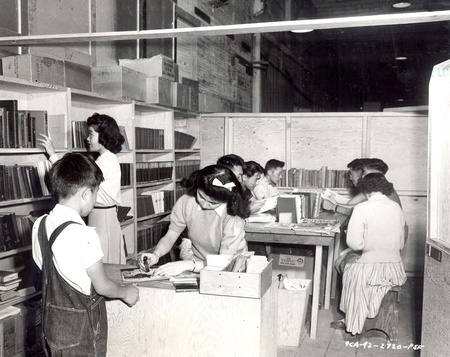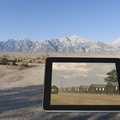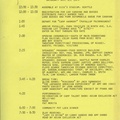Read Chapter 2 (5) >>
5. Towards the establishment of a library
Movements to establish libraries began in each camp. Margaret Baba Yasuda, who was 17 years old at the time and was involved in the establishment of the library at the Puyallup camp, described the process as "a grassroots movement, volunteer work, and the result of people thinking that they had to do something rather than rot in the camp." 1 In the case of the Tanforan and Portland camp libraries, we will trace the situation at the time of their establishment based on an article written by Mary Ogi in the Library Journal (May 1, 1943 issue) and a report by Sister Tsuboi.
Tanforan Temporary Camp Library 2
During the first few days in the camp, everyone was confused and disoriented. But some people quickly took the initiative to think of ways to alleviate the suffering of others, like Kyoko Hosiga, a graduate of Mills College. It wasn't physical suffering. All the inmates knew that they would not have the comforts and conveniences they had been used to. But the 7,800 people wanted intellectual and spiritual encouragement and stimulation.
Hosiga herself said , " I don't remember who first encouraged me to start a library. I had no idea how to go about it, and no confidence in my ability to do it myself. But with donations, advice, and encouragement from Evelyn Steele Little, librarian at Mills College, I just kept going." 3
The library opened on May 4th, seven days after Hoshiga arrived at the camp, with 65 books and magazines donated by detainees laid out on the floor. There were only four picture books and ten comic books for children. There was no book catalogue yet, and no shelves or furniture, but the immediate need to provide books was given priority.
For the children, the library was one of the least camp-like places, so many efforts were made to attract them. The librarian even got involved in gardening, making morning glories bloom on the drab barracks wall at the library entrance, organizing events such as story time on Saturdays when elementary school children could come with their teachers to the library and get to know the librarian. Yoshiko, an elementary school teacher at the same camp, was one of the readers.
Ogi writes that the primary purpose of the camp libraries was to maintain morality within the camp, to act as a bulwark against delinquent tendencies, and to provide children with a meaningful way to pass the time; the lending of books for normal entertainment and study was secondary.
In June, the military confiscated all books and magazines written in Japanese, making them prohibited items. The one copy of a novel by Kan Kikuchi that was in high demand was also taken away. The Issei became "orphans when it came to books."
Then books started arriving from libraries and schools with caring librarians. Clara B. Dills of the San Mateo County Library visited multiple times and brought over 400 discarded books. By September 1, the collection had grown to 6,000 books.
But then the preparations for the journey began again: they carefully removed the nails from the bookshelves, took out the wood, and used them to make wooden boxes, which they then packed with books and sent to the next concentration camp.
Portland Asylum Library 4
In May, even in the Portland temporary camp, efforts were underway to establish a library. The two sisters were Yasuko and Haruko, Nisei Tsuboi sisters who had been working as page 5s at the Portland Public Library until the day of their forced eviction. The Portland Library Association had promised to provide assistance with books if the eviction lasted more than a few days, from the time rumors of the eviction began to spread, so it seemed like things would go smoothly. However, there were two big obstacles. The first was that the main purpose of recreation for the Wartime Civilian Administration was to tire the body to the point that there was no energy to complain. Baseball, basketball, volleyball, etc. were attracting attention, and in comparison, the library was a clear luxury, although it was good to have one, and they were reluctant to do so. The second was a shortage of wood. This made it difficult to obtain permission to establish a library and to arrange for materials to build shelves.

We went around to various departments for a week to ask for their cooperation, but to no avail, so we finally decided to appeal directly to Director Emil Sundquist. We explained that hundreds of children were wasting their time with nothing to do, that we had the cooperation of the local library, and that we wanted to work at the library again. We also explained that all we needed now was a few shelves. The Director listened with interest and immediately gave us instructions to make the shelves.
On Friday, May 14th, the shelves were not yet complete, but 1,000 books arrived from the Portland Library Association. People who saw the books repeatedly said, "Just one book is fine," and "We'll bring it right away," so it was difficult to get them to wait. Somehow, by the evening, the shelves were completed and the book catalog was made, and the books were arranged on the shelves the next day, Saturday morning, and books were loaned out in the afternoon. The library officially opened on May 16th, but we did so because we thought, "Everyone absolutely needs books right now." At the end of the first week, the library was so successful that all the books on the shelves were gone, and children quickly became the library's biggest users. Children who had nothing to do but play visited the library several times a day, and many of them read at least two books a day. There were 400 children's books, but due to these circumstances, children's books were only loaned out for one day.
The enthusiastic response that Sister Tsuboi received during the first week convinced her of the need for adequate books to provide spiritual sustenance for the inmates. Having been suddenly thrown from their normal work lives into a camp with nothing to do, the inmates needed not only physical activity but also mental activity. Director Sundquist also called the establishment of the library "the best thing that ever happened to the camp." The Portland Library Association had envisioned the internee library as a branch and had scheduled book deliveries every week, but wartime restrictions on gasoline and tires meant that deliveries were reduced to once a month. 6
The Tsuboi Sisters' report also touches on the ages of the people in the camp. Of the 3,500 internees, 1,000 are of the parent generation. The average age of the internees is between 17 and 19, so the majority are second-generation young people and children. 55 are college graduates, 75 were college students before the eviction, and 40 had attended college at some point. Of the students who had just graduated from high school, about 200 have applied through the Student Relocation Committee7 to start college in the fall. These figures show that Japanese Americans are above average in terms of education, even when compared to towns of a similar size in the United States.
The day of their move to the new location inland in the fall is fast approaching. "This time, we will have a much larger community of 10,000 people, so we will have more difficult problems than ever before. However, we hope to be able to get books again and build a new library. Finally, Sister Tsuboi's report ends with a word of gratitude: "Without the help of the Portland Library Association, this library would not have been possible."
Notes:
1. Wertheimer, Andrew B. Japanese American Community Libraries in America's Concentration Camps, 1942 – 1946. [Doctoral dissertation] University of Wisconsin-Madison: 2004.
2. Ogi, Mary. The Tanforan Assembly Center Library . Library Journal. Vol. 68, May 1, 1943.
After leaving the camp, Mary Ogi studied library science at the University of Denver, during which time she wrote this article.
3. Wertheimer, Andrew B. Japanese American Community Libraries in America's Concentration Camps, 1942 – 1946. [Doctoral dissertation] University of Wisconsin-Madison: 2004.
4. Tsuboi, Yasuko Fukano. “Yasuko Fukano papers” 1942, University of Washington Libraries Special Collections.
5. Returning books to the shelves and bringing books from the storage room, a job mainly done by students.
6. The Portland Library Association's 1942 report states, "Even before the evacuation of the Japanese began, we had been planning how to provide library services to the camps. We were fortunate to have two excellent former pagers working as adult and children's librarians in the camp library. They kept the books to be sent to the camps in a specially prepared room and waited there. We also started a book ordering service. Many of the books were read, and when we received heartfelt gratitude, as you will see in the next report, we felt that it was really worth providing the books." Next, Yasuko Tsuboi's report continues: "According to the military officials, this is the only camp library that receives regular books from the city library and has a sufficient number of books. Carpenters, sign painters, hospital workers, teachers, recreation instructors, and other people who have taken up new jobs are requesting books related to their new jobs. Of course, novels are the most popular, but they don't seem to be very interested in current events. ... It is good that people who didn't read much before are now reading books in their spare time. Students are especially grateful for the book ordering service."
Personal communication with Matt, Librarian, Information Services, Multnomah County Library, April 10, 2013.
7. American Friends of the Church of St. John the Divine (AFSC) Committee to Support Inmates in Getting into College
*Reprinted from the 134th issue (July 2013) of “Children and Books,” a quarterly magazine published by the Children’s Library Association.
© 2013 Yuri Brockett






